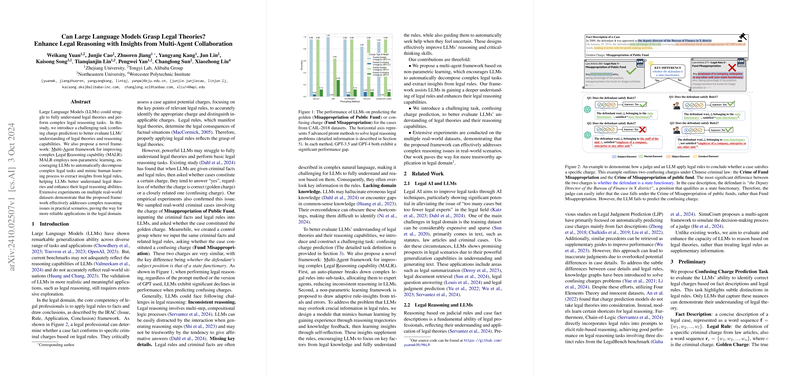Can LLMs Grasp Legal Theories? Enhance Legal Reasoning with Insights from Multi-Agent Collaboration
The research paper investigates the capabilities of LLMs in comprehending legal theories and executing complex legal reasoning tasks. The core argument is that while LLMs have showcased significant generalization abilities across various domains, they tend to struggle with understanding intricate legal concepts and making complex legal inferences, as legal reasoning encompasses multilayered, compositional logical processes. This paper introduces a novel Multi-Agent framework, termed MALR, which is designed to improve LLMs’ capacity for handling complex legal reasoning by utilizing non-parametric learning.
Objectives and Core Contributions
The paper aims to evaluate the ability of LLMs to identify correct legal charges based on fact descriptions and intricate legal rules. It introduces a Confusing Charge Prediction task, where LLMs must discern between legally similar but distinct charges. Key contributions of the research include:
- Proposing the MALR Framework: This involves decomposing complex legal tasks into smaller sub-tasks through an Auto-Planner, which allows LLMs to cohesively digest legal information and draw insights from legal rules.
- Implementing Adaptive Rule-Insights Training: The framework helps in enhancing LLMs’ understanding of legal rules by deriving insights from contrasting successful outcomes with errors in reasoning, thus mimicking human learning.
- Extensive Experimental Validation: Conducted on real-world datasets, showcasing the framework's effectiveness in improving the reliability of LLMs in practical legal scenarios.
Methodology
The methodology is grounded in a structured, systematic approach:
- Task Decomposition via Auto-Planner: This component employs LLMs to break down complex legal inquiries into manageably defined sub-tasks, reducing the inconsistencies typically observed in LLM-generated reasoning.
- Role Assignment for Sub-task Agents: After decomposing tasks, agents tackle specific legal aspects independently, minimizing distraction and enhancing focus on key facts through a multi-agent system.
- Adaptive Rule-Insights Training: Utilizes a reflection mechanism where LLMs learn through trials and errors, capturing the core judgment factors essential for distinguishing similar legal charges. Insights are systematically drawn from successful reasoning trajectories and failures, promoting a comprehensive understanding of legal rules.
- Reasoning Enhancement via Insights: The acquired insights complement the legal rules by guiding LLMs to achieve more refined and precise legal reasoning.
Findings
Empirical results demonstrate that the MALR-framework significantly surpasses existing baseline methods such as Zero-shot and Few-shot Collaboration of Thought (CoT), especially in distinguishing confusing charges. Notably, the paper indicates that the MALR framework not only aids in synthesizing legal rules to different scenarios but also shows noticeable improvement when applied to smaller or less capable LLM variants, highlighting scalable enhancements in reasoning capabilities.
Furthermore, the research underlines a key observation: LLMs' tendency towards positive affirmations, irrespective of the accuracy concerning legal rule applications, can be mitigated through structured reasoning and agent collaboration.
Implications and Future Directions
The implications of this research extend both theoretically, in understanding the limitations and potential of AI in legal reasoning, and practically, in developing more reliable AI systems for legal applications. The MALR framework’s approach to enhancing LLMs’ reasoning abilities holds promise for broader AI tasks involving complex logical reasoning across various domains outside the legal field, such as financial analysis or medical diagnostics.
The authors suggest potential areas for future research, including extending the implementation of the MALR framework into other specialized domains and exploring retrieval-augmented generation to further bolster LLM reasoning accuracy.
In summary, the introduction of Multi-Agent collaboration and non-parametric learning within the MALR framework marks a significant methodological advancement, enhancing the legal reasoning capabilities of LLMs and setting a foundational benchmark for future developments in AI-driven legal applications.
